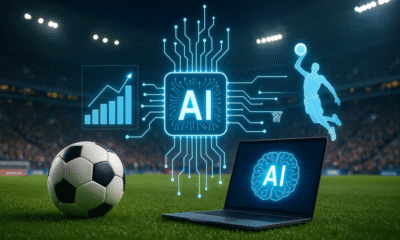Thought Leaders
Navigating Global Compliance: The Role of AI in MedTech

In the rapidly evolving landscape of MedTech, where innovation intersects with stringent regulatory frameworks, staying compliant while driving progress can be a daunting challenge. Amidst the backdrop of complex regulatory landscapes and the increasing interconnectedness of global markets, the incorporation of cutting-edge technologies such as AI becomes pivotal for organizations operating across borders. As regulatory requirements continue to evolve in complexity and scope, leveraging AI is no longer merely beneficial; it has become essential for efficiently and effectively navigating the intricate regulatory landscape.
With the integration of AI, tasks that were once time-consuming and tedious have been streamlined to enhance efficiency and accuracy in regulatory research. AI-powered tools offer the capability to navigate vast databases, analyze clinical research data, streamline document searches, and access worldwide regulatory news. In doing so, they equip stakeholders with the insights needed to remain abreast of regulatory changes and make well-informed decisions amidst the dynamic regulatory landscape.
Streamlined Compliance Through Data Insights
In today's regulatory landscape, meeting compliance requirements is more critical than ever for businesses across industries. However, the sheer volume and complexity of regulations can often pose significant challenges, making it difficult for companies to navigate them efficiently. Fortunately, advancements in data analytics and technology are transforming the way organizations approach compliance, offering solutions to streamline processes and ensure adherence to regulatory standards.
One of the key drivers of this transformation is the utilization of big data analytics. With data analytics, companies can gain deeper insights into regulatory requirements, enabling them to identify potential areas of non-compliance and address risks proactively. For instance, organizations can aggregate and analyze vast amounts of data from various sources, such as internal records and industry databases, to uncover patterns and trends that inform more robust compliance strategies tailored to their specific needs.
Our internal platform, GRIP, exemplifies how comprehensive data insights can simplify compliance processes. By providing a centralized hub for accessing regulatory information and identifying open access points, one-stop search solutions like GRIP streamline the compliance journey, saving valuable time and resources for regulatory professionals, compliance officers, and innovators in the MedTech sector.
Predictive analytics also plays a crucial role in anticipating regulatory changes and their potential impact on business operations. By leveraging historical data and machine learning algorithms, companies can forecast regulatory trends and proactively adapt their compliance processes accordingly. This proactive approach not only helps companies stay ahead of regulatory changes but also minimizes the risk of non-compliance penalties and reputational damage.
Additionally, the integration of automation technologies such as robotic process automation (RPA) and artificial intelligence (AI) is streamlining compliance workflows. These technologies streamline the execution of repetitive tasks while minimizing manual errors, thereby optimizing efficiency, accuracy, and scalability across various compliance processes. By automating mundane tasks, these technologies also allow organizations to allocate resources more strategically.
Overall, streamlined compliance through data insights enables organizations to navigate regulatory environments effectively, reduce compliance costs, and mitigate risks proactively. By utilizing data analytics, predictive analytics, and automation technologies, companies can gain a competitive edge in regulatory compliance while fostering innovation and growth in their respective industries.
Efficiency Through Innovation: Regulatory Monitoring
Remaining up to date with worldwide updates and modifications is essential in the dynamic field of regulatory affairs. Regulatory monitoring stands at the forefront of compliance management, requiring organizations to stay abreast of constantly evolving regulations across multiple jurisdictions and industries. Traditionally, this process has been resource-intensive and time-consuming, often involving manual searches, thorough reviews of regulatory publications, and coordination among various stakeholders. However, with the development of recent technologies, companies can now leverage automation and advanced analytics to enhance the efficiency of their regulatory monitoring efforts.
One notable innovation in regulatory monitoring is the integration of natural language processing (NLP) and machine learning algorithms. These tools automate the collection and analysis of regulatory information by scanning vast amounts of textual data from regulatory websites, news sources, and legislative documents. By identifying relevant updates, extracting key information, and categorizing regulatory changes based on their potential impact, these technologies streamline the monitoring process.
Moreover, intelligent monitoring systems equipped with AI capabilities continuously enhance the accuracy and relevance of regulatory alerts. By learning from past regulatory events and user interactions, these systems prioritize alerts based on their relevance to specific business operations. This adaptive approach optimizes resource allocation and decision-making processes, ensuring organizations focus on critical regulatory updates.
Cloud-based platforms and regulatory intelligence solutions offer a centralized hub for managing and monitoring regulatory compliance activities. Providing real-time access to regulatory updates, compliance documentation, and audit trails, these platforms enable organizations to streamline collaboration, track compliance status, and demonstrate accountability to stakeholders.
Aside from advancements in technology, forging partnerships with regulatory experts and industry associations can offer invaluable insights and guidance on emerging regulatory trends and best practices. Through collaboration and knowledge-sharing with external stakeholders, companies can enrich their regulatory intelligence capabilities and stay ahead of the curve in compliance management.
By innovating regulatory monitoring processes, organizations gain the ability to proactively identify and respond to regulatory changes, mitigate compliance risks, and drive operational excellence. Embracing advanced technologies, forming strategic partnerships, and adopting best practices cultivates a compliance-focused culture that not only meets regulatory standards but also facilitates sustainable growth and competitive advantage.
The Future of Regulatory Management: AI Digital Tools
Looking ahead, leveraging the capabilities of AI-powered digital tools will be key to the future of regulatory management. Given that AI-powered platforms not only streamline organization but also provide seamless translation into multiple languages, it's evident that these platforms improve compliance efficiency while also increasing accessibility. This enables global collaboration and communication, fostering enhanced connectivity and cooperation across diverse regions and stakeholders.
In conclusion, AI-powered platforms represent a paradigm shift in MedTech regulatory compliance, offering companies unprecedented agility and confidence in navigating complex regulatory landscapes. By harnessing these platforms, stakeholders can seamlessly navigate regulatory landscapes, leveraging streamlined compliance through data insights and efficient regulatory monitoring. AI-powered platforms pave the way for a future where regulatory compliance is synonymous with innovation and efficiency, driving the MedTech industry towards greater advancement.












